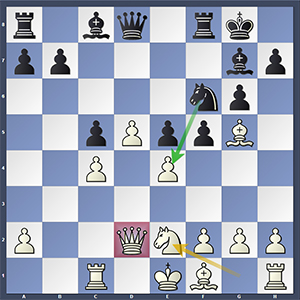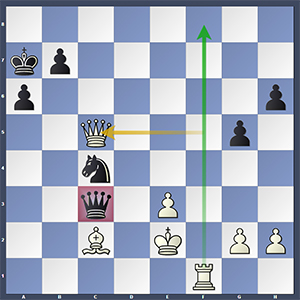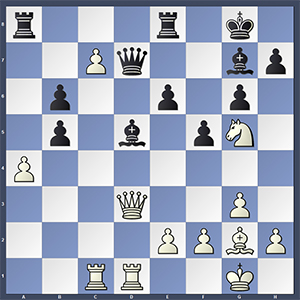
The 8th London Chess Classic, got underway in Olympia, London, on Friday 9th December.
Round 1 was a largely decisive day, with only two games ending in a draw. These were Caruana-Anand, which was an English Opening, in which neither player seemed to want to sharpen things up when given the opportunity. 26…exf4 may have offered Anand more than his chosen …c5; and, when Caruana did not go for 32. e4-e5, it was already looking like the players didn’t really want to get in to it. The draw was eventually agreed in 44-moves, not a huge surprise. The ceasefire was declared a lot quicker in Giri-Vachier-Lagrave. Their Najdorf had hardly got started before they were repeating moves.
Luckily, there was excitement elsewhere, with the rest of the games producing points. Hikaru Nakamura had a very bad day at the office, blundering badly in his game against Wesley So. Already lagging somewhat in development, Nakamura went for 13.Ne2… (D)

Black continues 13…Nxe4!
And here there is an important question: When is a pin not a pin? Answer: When your own piece is also not the safest. That is what happened in this instance, the move allowed 13…Nxe4(!) and the point was not especially the pawn, but the activity and initiative that Black had been handed on a plate. White never recovered. A good part of that was that Black never allowed him to, So making the absolute most of his chance.
Michael Adams also let things slip, as Black against Levon Aronian. White didn’t have the best of openings, to be fair and ended up quite passive. 26.Bg3 tempted Black with a pawn and this was accepted with …Qxa2. From here White had good activity and ended up getting his investment back. 33…Ka8(??) allowed 34.Rxd8 Rxd8 35.Qf6 and Black had a knight and rook problem. It is implausible to consider that Michael Adams missed this possibility, his calculation must have gone wrong somewhere after this point. However, after 35…Nc4 36.Qxd8+, he was a rook down without compensation. Resignation followed not long after, when he was in the unpleasant situation of having to hang his Queen in order to save a very quick mate. (D)

Black is quickly mated after …Ka7, …Kb8 or …b6.
…Nb6, hanging his Queen merely delays matters briefly.
The by now long established grudge pairing between Veselin Topalov and Vladimir Kramnik, saw the latter emerging the more satisfied. In the fianchetto Grunfeld, Topalov’s 15…Rd8(?) allowed Kramnik to advance his c-pawn and this became a real thorn in Black’s side, getting all the way to the 7th rank. White obtained full control in the game, and Black’s chances of resistance became non-existent and the Bulgarian was soon resigning.

This leaves a 3-way tie at the top, then, but it is very early days and there is a lot of chess left. Round 2 is on Saturday December 10th, 14:00 GMT (check your time here.).
[Site “London ENG”]
[Date “2016.12.09”]
[Round “1.1”]
[White “Nakamura, Hikaru”]
[Black “So, Wesley”]
[Result “0-1”]
[ECO “D85”]
[WhiteElo “2779”]
[BlackElo “2794”]
[PlyCount “58”]
[EventDate “2016.12.09”]{ Annotations by John Lee Shaw for www.hotoffthechess.com. }
1. d4 Nf6 2. c4 g6 3. Nc3 d5 4. cxd5 Nxd5 5. e4 Nxc3 6. bxc3 Bg7 7. Be3 c5 8.
Rc1 O-O 9. Qd2 e5 {This seems to be an invention of Peter Svidler, who played
it, without success, against Yury Dokhoian in Copenhagen, 1991.} 10. d5 Nd7 {
A new move.} 11. c4 f5 12. Bg5 Nf6 {Black will be rather content, here,
White’s Bg5 has not interfered with his plans at all, while his Kingside is as
yet undeveloped.} 13. Ne2 {? A mistake by Nakamura, as So demonstrates.} Nxe4 {
! A strong continuation, made possible due to the placement of the White Queen.
} (13… fxe4 {is less effective and this is probably the capture that
Nakamura expected.} 14. Nc3 {Black’s best option is probably to give the pawn
straight back, but on his own terms.} e3 15. fxe3 {With a bit of an edge.}) 14.
Bxd8 Nxd2 {With a very big edge, not because of the pawn, which after Be7 is
only temporary anyway, but White still has developmental problems to solve.
This, and regaining his pawn, will cost him time.} 15. Be7 Rf7 16. Bxc5 Nxf1 {
Taking the bishop pair, which will start to come into its own as the position
opens more} 17. Rxf1 {The lesser of two evils, this, developing the rook
somewhat, but by no means optimum. White also has some King issues now,
having it in the centre of the board is far from ideal. White does have the
passed d-pawn going for him, however, but can he make use of that in order to
hold Black at bay?} b6 18. Bb4 Ba6 {Beginning to target White’s central pawns,
one always wants to attack a pawn chain at the base, …Rc8 will follow and
Black’s other rook is already ideally situated should Black want to double up
— big problems for White, here.} 19. f4 {This is not as positive a move as it
looks, White is trying to get active.} (19. c5 {The problem with this move, is
that it eliminates one problem, but creates a new one, namely that Black is by
far the more active and will then have an open Queenside to go at. He is
better placed to switch area’s of operation at will and White is in effect
playing a rook down.} bxc5 20. Bxc5 {And Black has choices, here, …Rc8, …
Rd7, …Rb7 are all extremely strong.}) 19… Rc8 {The c-pawn is not
salvageable and this will mean that White’s passed pawn will soon also be
under the same pressure. White is simply losing, here.} 20. fxe5 Bxe5 21. Rf3 {
Nakamura finally gets this rook into the game, but not without cost. It is a
bit too little, too late.} Bxc4 {With a huge position.} 22. Re3 Bg7 23. Nf4 Rd7
{So turns his attention to the d-pawn, …Bh6 will follow in order to deal
with the Nf4 defender.} 24. a4 Bh6 25. g3 Bxf4 26. gxf4 Rxd5 {Mission
accomplished for Black, White’s game is over bar the shouting, here.} 27. Re7
Rd4 28. Bd2 Kf8 29. Bb4 Re8 {And here, Hikaru Nakamura resigned. He must
exchange rooks, due of course to the pin on his King, after which Black will
have even more of an overwhelming endgame. A disappointing game from Hikaru,
who lost this game rather early on, with a mistake that one would not expect
from a Grandmaster of his calibre. All credit to Wesley So, though, who took
full advantage of that mistake with very good chess.} 0-1[Event “London Chess Classic 2016”]
[Site “London ENG”]
[Date “2016.12.09”]
[Round “1.3”]
[White “Kramnik, Vladimir”]
[Black “Topalov, Veselin”]
[Result “1-0”]
[ECO “D77”]
[WhiteElo “2809”]
[BlackElo “2760”]
[PlyCount “55”]
[EventDate “2016.12.09”]{Annotations by John Lee Shaw for www.hotoffthechess.com.} 1. Nf3 d5 2. g3 g6
3. Bg2 Bg7 4. d4 Nf6 5. O-O O-O 6. c4 c5 7. dxc5 dxc4 8. Na3 c3 {Unable to
hold on to his pawn, Topalov gives it back on his terms, giving Kramnik a
couple of isolated pawns to consider. This is still known territory so far, so
Kramnik is unlikely to mind this in the slightest.} 9. Nb5 cxb2 10. Bxb2 {
This position shows up twice in my database, each with different continuations
from this point, …Na6 and …Nc6. Both games had been drawn.} Bd7 {Topalov
goes his own way.} 11. Qb3 Bc6 {Topalov showing pretty good prep and making
what is arguably the best move, here. …Nc6 was also a good alternative, but
Black wants to situate the light-squared bishop on the long diagonal rather
than have it sitting on d7. …Qa5 looks rather tasty, but White has a2-a4. I
would have also considered …Be6, which at first glance looks rather horrid
(and indeed may be) but psychologically it may be the most annoying move for
White.} (11… Be6 12. Qc2 Nc6 13. Rfd1 Qc8 14. Rac1 {and I don’t know, but
Black might be alright here, with the option of …Bh3 to follow.}) (11… Qa5
12. a4 a6 13. Bc3 Qd8 {and White is fine after either Nbd4 or Na3.}) 12. Rfd1 {
A very natural move.} Qc8 13. Rac1 Nbd7 14. Nbd4 Bd5 15. Qa3 Re8 {? A slip by
Topalov, which allows Kramnik to continue powerfully.} 16. c6 {! A nice move,
seizing the initiative.} Nb6 (16… bxc6 {(…Bxc6, Ng5!)} 17. Nxc6 {and the
position is opening in White’s favour, here.} Qb7 {…Bxc6 would be met by Nd4.
} 18. Ng5 e6 19. Bxd5 exd5 20. Rc2 {with by far the best of things.}) 17. c7 {
Just one way to proceed, Ng5 was also a good alternative, with the objective
of getting rid of Black’s tidy bishop. I like Kramnik’s move, though, this
pawn is very discomforting for Black and is going to be hard to deal with.} (
17. Ng5 h6 18. Bxd5 Nfxd5 {Ngf3 or e4 is good for White, here, it is a matter
of taste.}) 17… Nc4 18. Qb4 Nxb2 19. Qxb2 b6 20. Qa3 {This is a little out
of context, and actually gives Black an opportunity to fight, albeit a futile
one. Better for Kramnik, here, was Ng5, immediately targetting Black’s
d5-bishop and taking the bite out of Black’s intended …Qb7.} e6 {Topalov
fails to take advantage of the time given to him for …Qb7 and this is really
a missed opportunity to put up something of a fight.} (20… Qb7 {this is
perhaps the most testing, but with correct play by White, should still see him
in charge.} 21. Bh3 e6 22. Ng5 h6 23. e4 Nxe4 24. Nxe4 Bxe4 25. Nb5 Bf8 26. Nd6
Bd5 27. Nxb7 Bxa3 28. Rxd5 exd5 29. c8=Q Raxc8 30. Rxc8 Rxc8 31. Bxc8) 21. Nb5
{Black is going to have a tough time from here, White has a very substatial
grip on the position and that c7-pawn is very significant.} Bf8 22. Qb2 Bg7 23.
Qd2 Qd7 24. a4 Ne4 25. Qf4 a6 26. Qxe4 axb5 27. Qd3 f5 28. Ng5 {And here,
Veselin Topalov resigned, Vladimir Kramnik has an overwhelming control on the
position and his threats towards e6 and d5 are decisive.} 1-0[Event “London Chess Classic 2016”]
[Site “London ENG”]
[Date “2016.12.09”]
[Round “1.5”]
[White “Aronian, Levon”]
[Black “Adams, Michael”]
[Result “1-0”]
[ECO “C50”]
[WhiteElo “2785”]
[BlackElo “2748”]
[PlyCount “81”]
[EventDate “2016.12.09”]{Annotations by John Lee Shaw for www.hotoffthechess.com.} 1. e4 e5 2. Nf3 Nc6
3. Bc4 Bc5 4. d3 Nf6 5. c3 d6 6. Bg5 h6 7. Bh4 a6 8. Nbd2 Ba7 9. Bb3 Qe7 10.
Nc4 Be6 11. Ne3 g5 12. Bg3 O-O-O 13. Ba4 {By transposition, the game follows
Meier-Stetsko, Krakow 2015.} Nb8 14. Qc2 {A new square for the Queen — in the
above game, Meier chose e2 and the game resulted in a win for him.} Bxe3 15.
fxe3 Nh5 16. Bf2 f5 17. exf5 Bxf5 18. Qe2 {So the Queen ends up transferring to
e2 after all, and it is very hard to see what improvement Aronian’s novelty
has brought him. I think Adams would be rather content, here.} Bxd3 {Adams
takes advantage of a tactic, but patience may have been better.} (18… Rhf8
19. Bc2 Bg6 {and this is not a very positive setup at all for White.}) 19. Qxd3
e4 20. Qd4 c5 21. Qd1 exf3 22. Qxf3 {Things are about equal, here, but Black
has problem knights and these will take some time to redevelop. On the other
hand, White is a bit confined and his Bf2 is not looking too handy either.} Nf6
23. Bc2 Nbd7 24. O-O-O Ne5 25. Qe2 Qe6 26. Bg3 {Tempting Black with a pawn.}
Qxa2 {Adams decides to accept.} 27. Rhf1 (27. Bxe5 dxe5 28. Qf3 Qa1+ 29. Bb1
Nd7 30. Qg4 {a very useful pin, this, with options of Rd2 and Rhd1.} h5 31. Qe6
Rhe8 32. Qg6 {Black should be ok with correct play.}) 27… Nd5 28. Bxe5 {
This is necessary — other moves are too slow and White gets little for his
pawn.} dxe5 29. Bb1 Qb3 30. Bc2 Qa2 31. Qg4+ Kb8 32. Qe4 Nb6 33. Qxe5+ {
recouping his pawn.} Ka8 {?? A very bad slip, unlike Michael Adams.} (33… Ka7
34. Qxc5 Rxd1+ (34… Qa1+ 35. Bb1 Rc8 36. Qd4 Rhd8 37. Qxd8 Rxd8 38. Rxd8 {
sees White with a very slight pull, his extra pawn and passer making a lot of
difference.}) 35. Rxd1 {About equal — Black is probably best refusing the
natural check and opting for …Rc8.}) 34. Rxd8+ Rxd8 35. Qf6 {It is very
unlikely that Michael Adams missed this simple move.} Nc4 36. Qxd8+ Ka7 {
So we see, here, that Black threatens …Qxb2+ followed by …Nxe3+, but this
is very simply answered by White.} 37. Qd3 {So White is now a rook to the good,
and it is hard to see what Black intended from here.} Nxb2 38. Qf5 Qa1+ 39. Kd2
Nc4+ 40. Ke2 Qxc3 {?? the final mistake, but Black was losing in all kinds of
ways anyway.} 41. Qxc5+ {And the only way to stop a quick mate is …Nb6,
leaving his Queen hanging. Michael Adams resigned.} 1-0
[Event “London Chess Classic 2016”]
[Site “London ENG”]
[Date “2016.12.09”]
[Round “1.2”]
[White “Caruana, Fabiano”]
[Black “Anand, Viswanathan”]
[Result “1/2-1/2”]
[ECO “A21”]
[WhiteElo “2823”]
[BlackElo “2779”]
[PlyCount “87”]
[EventDate “2016.12.09”]
{Annotations by John Lee Shaw for www.hotoffthechess.com.} 1. c4 e5 2. Nc3 Bb4
3. Nd5 Bc5 4. Nf3 c6 5. Nc3 d6 6. g3 Nf6 7. Bg2 O-O 8. O-O Re8 9. d3 h6 10. Na4
{According to my database, this natural move is a new approach in this
position.} Bb4 11. a3 Ba5 12. b4 Bc7 13. e4 Bg4 14. h3 Bxf3 15. Qxf3 Nbd7 16.
Qd1 a6 17. Nc3 Bb6 18. Ne2 a5 19. Bb2 Qe7 20. Kh2 axb4 21. axb4 Rxa1 22. Qxa1
h5 23. Kh1 h4 {White is dawdling around a little, so Black takes the
opportunity to make his presence known also on the Kingside.} 24. g4 {
Absolutely not gxh4, when after …Nh5, Black is doing rather well.} Nh7 25. f4
Be3 26. Bc3 c5 {Taking the quiet option, …exf4 offered more.} (26… exf4 27.
Nxf4 Ne5 {With a nice position.}) 27. bxc5 Nxc5 28. Qb1 Ra8 29. d4 exd4 30.
Nxd4 Bxd4 31. Bxd4 Rc8 32. Ba1 {e4-e5 was a bit more pushy.} (32. e5 dxe5 33.
Bxe5 Rd8 34. Bd5 {With White’s bishop pair coming into their own in this
position.}) 32… Nf6 33. e5 dxe5 34. Bxe5 {This is not quite as effective,
now, Black has had time to activate his knight and this makes a big difference.
} Nfd7 35. Bc3 Qe3 36. Ba1 Re8 37. Qb2 Nf6 38. Qd4 b6 39. Qxe3 Rxe3 {The game
is unlikely to go anywhere from here, both players have rather tidy positions
and unless a mistake is made, there are no threats.} 40. Bd4 Rd3 41. Bf2 Rc3
42. Bxh4 Rd3 43. Bf2 {Bxf6 busts Black a bit, but in the longterm seems to get
White nowhere with correct play.} (43. Bxf6 gxf6 44. Rb1 f5 45. gxf5 Nd7 46.
Rb5 Rc3 47. Rb4 Nf6 48. Rxb6 Nh5 49. Bd5 Rxh3+ 50. Kg1 Nxf4 {and Black has
enough to survive, here.}) 43… Rc3 44. Bh4 {And the players shook hands,
here and split the point.} 1/2-1/2
[Event “London Chess Classic 2016”]
[Site “London ENG”]
[Date “2016.12.09”]
[Round “1.4”]
[White “Vachier-Lagrave, Maxime”]
[Black “Giri, Anish”]
[Result “1/2-1/2”]
[ECO “B90”]
[WhiteElo “2804”]
[BlackElo “2771”]
[PlyCount “47”]
[EventDate “2016.12.09”]
{Annotations by John Lee Shaw for www.hotoffthechess.com.}
1. e4 c5 2. Nf3 d6 3. d4 cxd4 4. Nxd4 Nf6 5. Nc3 a6 6. h3 e5 7. Nde2 h5 8. g3
Be6 9. Bg2 b5 10. O-O Nbd7 11. Be3 Be7 12. Nd5 Nxd5 13. exd5 Bf5 14. f4 {
Interestingly, Vachier-Lagrave has been in this positon before, but with the
Black pieces — against Fabiano Caruana, Stavanger 2015. The game was a draw.}
Rc8 {A new move — usually it is the Queen that occupies this square, here.}
15. c3 Bh7 16. a4 O-O 17. axb5 axb5 18. Ra6 exf4 19. Nxf4 h4 20. Bd4 Ne5 21.
Nh5 Bg6 22. Nf4 Bh7 23. Nh5 Bg6 24. Nf4 {And here, the players agreed a draw.}
1/2-1/2
[/pgn]

